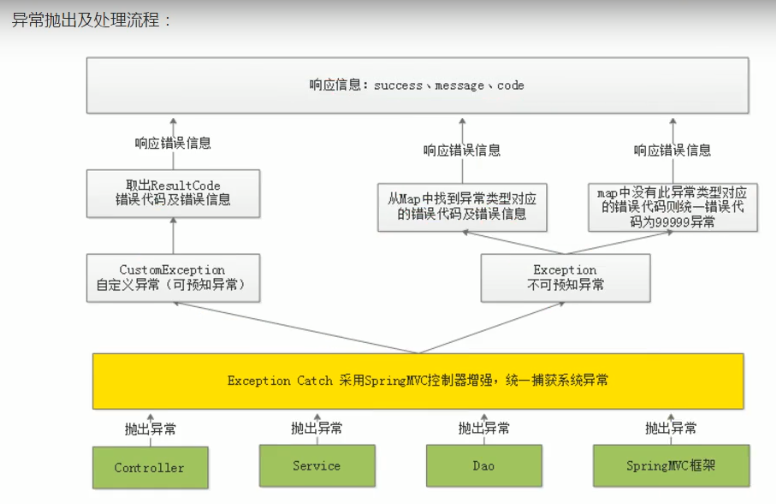出现异常后,跳转指定的页面
不配置spirng-MVC.xml
Controller
方式1;
//处理异常,注意入参中,不能有Model,Map等,如果需要给requestion添加对象,使用ModelAndView
@ExceptionHandler({ArithmeticException.class})
public ModelAndView ArithmeticException(Exception ex){
ModelAndView modelAndView = new ModelAndView("error");
modelAndView.addObject("ex",ex);
return modelAndView;
}
@RequestMapping(value = "/testexception",method = RequestMethod.GET)
public String testexception(){
int a = 1/0;
return "login";
}
方式2:
我们重新创建一个类(类名无关),将上面处理异常的方法放进去;
@ControllerAdvice
public class HandleException {
@ExceptionHandler({ArithmeticException.class}) //捕获指定的异常
public ModelAndView ArithmeticException(Exception ex){
ModelAndView modelAndView = new ModelAndView("error");
modelAndView.addObject("ex",ex);
return modelAndView;
}
}
配置spirng-MVC.xml
controller不需要在写异常处理的方法了。
<!--key:需要些错误的全限定路径-->
<bean class="org.springframework.web.servlet.handler.SimpleMappingExceptionResolver">
<!--配置异常的名字-->
<property name="exceptionAttribute" value="ex"></property>
<property name="exceptionMappings">
<props>
<prop key="java.lang.ArithmeticException">error</prop>
</props>
</property>
</bean>
@ResponseStatus注解
1、如果这个注解放在的方法上:直接放回一个错误页面
@ResponseStatus(reason = "测试",value = HttpStatus.NOT_FOUND)
@RequestMapping(value = "/testexception",method = RequestMethod.GET)
public String testexception(){
return "login";
}
1、注解类
定义一个错误的类
@ResponseStatus(reason = "错误消息",value = HttpStatus.BAD_REQUEST)
public class MyException extends Exception{
public MyException(){
super();
}
public MyException(String message){
super(message);
}
}
controller
@RequestMapping(value = "/testexception",method = RequestMethod.GET)
public String testexception() throws MyException {
if (true){
MyException myException = new MyException();
throw myException;
}
return "login";
}

编写统一处理异常类
可预知异常处理(由程序员自己抛出的异常)
1、编写一个错误类继承RunTimeException,不继承Exception的原因是,在代码中手动抛出RunTimeException异常,在代码中不需要进行try...cache等
public class CustomException extends RuntimeException {
//错误代码信息(自己定义)
ResultCode resultCode;
public CustomException(ResultCode resultCode){
this.resultCode = resultCode;
}
public ResultCode getResultCode(){
return resultCode;
}
}
2、service层抛出异常
if(cmsPage1!=null){
//页面已经存在
//抛出异常,异常内容就是页面已经存在
throw new CustomException(CmsCode.CMS_ADDPAGE_EXISTSNAME);
}
3、编写捕获异常类
@ControllerAdvice//控制器增强
public class ExceptionCatch {
private static final Logger LOGGER = LoggerFactory.getLogger(ExceptionCatch.class);
//捕获CustomException此类异常
@ResponseBody //返回给前端json数据
@ExceptionHandler(CustomException.class) //捕获相应的错误类
public ResponseResult customException(CustomException customException){
//记录日志
LOGGER.error("catch exception:{}",customException.getMessage());
//获取错误码(自定义的)
ResultCode resultCode = customException.getResultCode();
return new ResponseResult(resultCode);
}
}
4、springboot配置(由于我们的捕获类写在了common模块中,所以spring boot启动的时候,需要扫描这个模块)
@SpringBootApplication
@EntityScan("com.xuecheng.framework.domain.cms")//扫描实体类
@ComponentScan(basePackages={"com.xuecheng.framework"}) //扫描common模块
public class ManageCmsApplication {
public static void main(String[] args) {
SpringApplication.run(ManageCmsApplication.class,args);
}
}
不可预知异常处理(由框架自己抛出)
1、对捕获异常类进行扩展
总结:捕获Exception异常(所有的异常),如果该异常在map中有对应的错误码(我们提前将可能出现的异常用map存储起来),返回该错误码
@ControllerAdvice//控制器增强
public class ExceptionCatch {
private static final Logger LOGGER = LoggerFactory.getLogger(ExceptionCatch.class);
//定义map,配置异常类型所对应的错误代码
private static ImmutableMap<Class<? extends Throwable>,ResultCode> EXCEPTIONS;
//定义map的builder对象,去构建ImmutableMap(ImmutableMap的使用需要定义builder对象,如果使用其他HashMap就不需要了)
protected static ImmutableMap.Builder<Class<? extends Throwable>,ResultCode> builder = ImmutableMap.builder();
//提前将系统可能抛出的异常代码添加相应的错误代码块
static {
//定义异常类型所对应的错误代码(注意此时ImmutableMap还没有数据,需要等待build())
builder.put(HttpMessageNotReadableException.class,CommonCode.INVALID_PARAM);
}
//捕获CustomException此类异常
@ResponseBody
@ExceptionHandler(CustomException.class)
public ResponseResult customException(CustomException customException){
//记录日志
LOGGER.error("catch exception:{}",customException.getMessage());
ResultCode resultCode = customException.getResultCode();
return new ResponseResult(resultCode);
}
//捕获其他框架抛出的异常
@ResponseBody
@ExceptionHandler(Exception.class)
public ResponseResult exception(Exception exception){
//记录日志
LOGGER.error("catch exception:{}",exception.getMessage());
if(EXCEPTIONS == null){
//此时,ImmutableMap构建成功,ImmutableMap有了数据,且ImmutableMap不能在被修改了(只读)
EXCEPTIONS = builder.build(); //我们可以直接put完数据之后,直接执行build()
}
//从EXCEPTIONS中找异常类型所对应的错误代码,如果找到了将错误代码响应给用户,如果找不到给用户响应99999异常
ResultCode resultCode = EXCEPTIONS.get(exception.getClass());
if(resultCode !=null){
return new ResponseResult(resultCode);
}else{
//返回99999异常
return new ResponseResult(CommonCode.SERVER_ERROR);
}
}
}